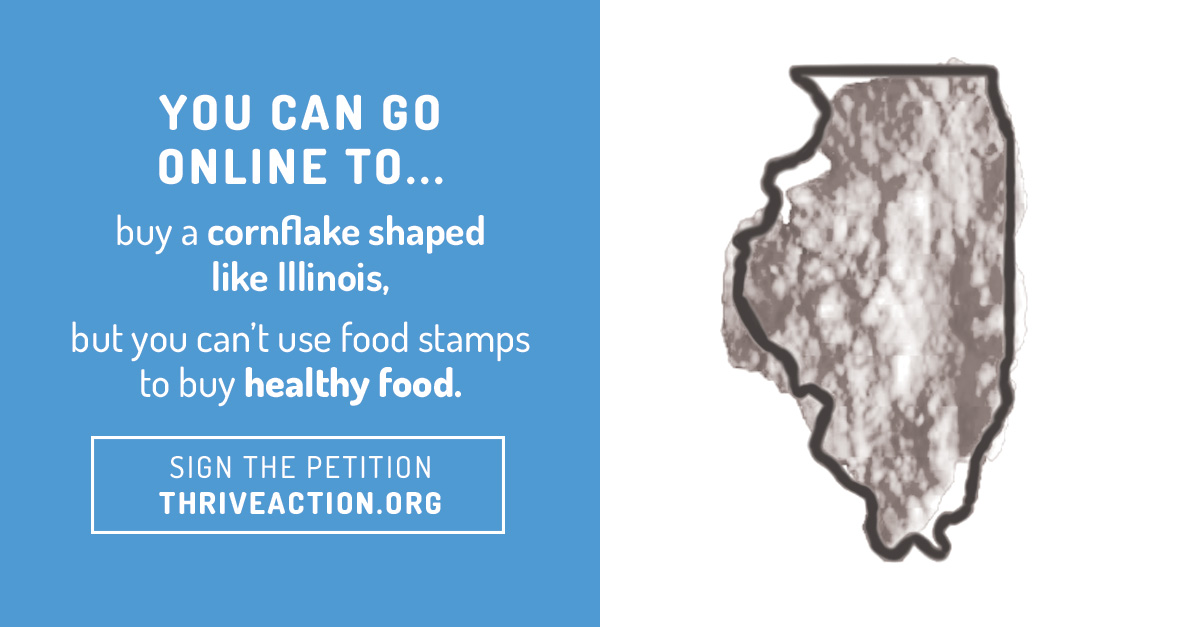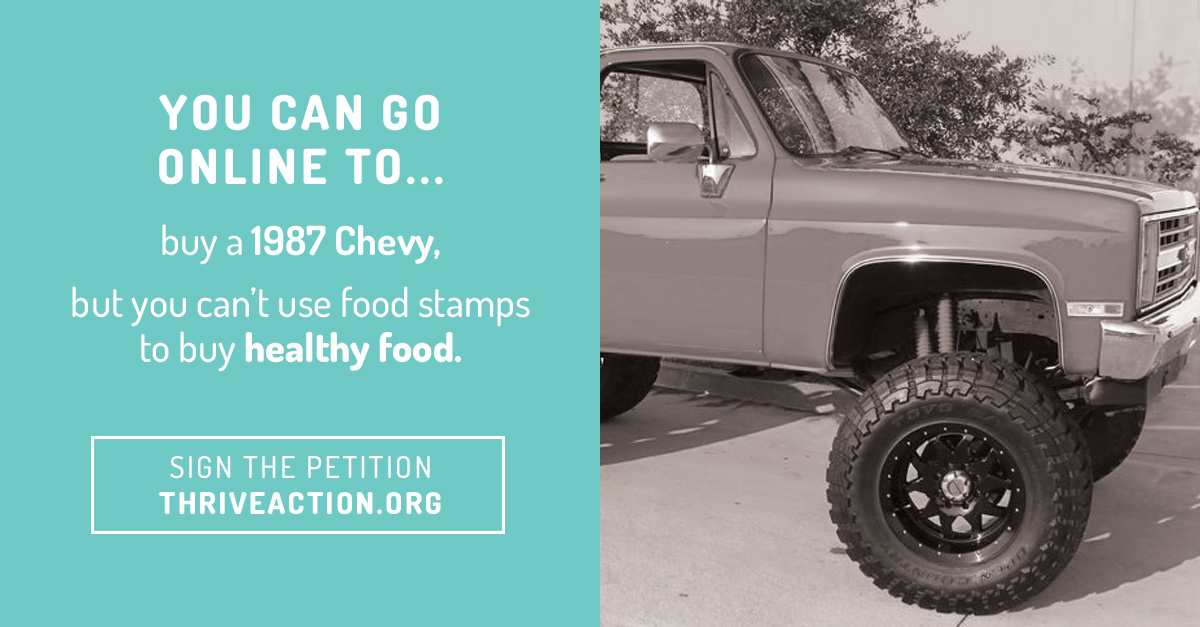Thrive Market Action: Thrive Market Petitions the USDA to Bring Food Stamps Online
Last Update: April 1, 2025
It’s easy to take the internet—and everything we use it for—for granted. And to forget that just 25 years ago it didn’t exist. Yes, there really was a time when you couldn’t pay a phone or electric bill online—writing out a check and searching for a stamp was your only option. Need to check your bank account balance? Head down to the bank and ask a teller. Want to renew a driver’s license? Get yourself to the DMV and be prepared to wait for hours. Life was pretty much one dreary errand after another.
Thankfully, technology has evolved—for most of us. So it’s surprising to hear that in an age where we can buy and do pretty much anything online—and pay with cash, credit, or bitcoin—people still can’t use food stamps online.
In America, 46.5 million people rely on the Supplemental Nutrition Assistance Program (SNAP)—formerly known as the food stamp program—to help them afford groceries [1]. Unfortunately, SNAP participants can’t use their benefits for online food shopping. In a country where 23.5 million people live in “food deserts” and don’t have easy access to brick and mortar grocery stores, requiring benefits to be used in-person creates an arbitrary barrier for millions of families. Our mission has always been to make healthy living accessible for everyone.
That’s why Thrive Market is petitioning the USDA to make food stamps available for online use.
The most important part of Thrive Market’s mission
Gunnar Lovelace, co-founder of Thrive Market, knows firsthand what it’s like to grow up in a food-insecure home, and he’s spoken openly about it. “When I was a child, there were many months when my mom and I lived off of rice—and that was it,” he says. When Lovelace founded Thrive Market in 2014, the company’s vision was firmly rooted in the social mission to make healthy food accessible to all, and that remains one of the most important components of his work. “I have a lot of compassion for people who don’t have their basic survival needs met, because that was me,” he says.
This vision has been brought to life with the Thrive Gives program, which gives free Thrive Market memberships to veterans, teachers, students, and low-income families. Members can shop more than 4,000 wholesome, healthy products at up to 50 percent off retail prices, and get everything delivered right to their door.
But we want to do more. As Lovelace puts it, “We’re serious about what we’re doing, and we want to help as many people as possible.” One way to do that? Allow food stamps to be used online.
Making food stamps redeemable online could change lives
There’s no doubt that SNAP is beneficial for many families—the program has the ability to propel millions out of poverty and into more stable living conditions. In fact, temporary access to SNAP benefits lifted 4.7 million Americans out of poverty in 2014 [2].
But there are major drawbacks to SNAP: Millions of recipients live in food deserts, which means the only places they’re likely able to use benefits at are gas stations and convenience stores. If the nearest grocery store is 30 miles away and you don’t have access to a car, shopping at 7-Eleven might be the only way to feed your family. That doesn’t exactly set the stage for healthy eating.
Here’s the thing about living in the digital age—internet access is more widespread than access to transportation. Even among lower-income families, 74 percent have internet access, but many are without a car. Ordering groceries from online stores is easier and offers better options than in-person shopping—in particular for those in food deserts. And because it’s easy to search for the best price on an item online, it’s usually cheaper.
All the same rules that apply to in-person SNAP purchases would apply to online shopping—no one will be able to use their benefits buy a new iPhone or book a flight to Hawaii. Participants would only be allowed to buy food items.
6 SNAP myths, debunked
It’s not surprising that government benefits like SNAP are so divisive. There’s a common, often unspoken assumption that receiving federal aid means that a person is lazy. But that couldn’t be further from the truth; in fact, 82 percent of households that receive benefits include a child, or an elderly or disabled person—people who often aren’t even eligible for employment. Further, a third of households on SNAP have at least one person with an earned income.
The important takeaway is that the people who rely on government aid are single moms with children to feed, veterans trying to get back on their feet, and elderly people who are unable to work—not people who don’t want to work. Here we disprove some of the fallacies surrounding the program.
Myth: Food stamps are easy to get.
Fact: Recipients need to meet specific qualifications and prove eligibility with paperwork.
Only those who are economically eligible get SNAP benefits—for a single person, that means a total income of less than $1,276 a month; for a family of four, the cutoff is a monthly income of $2,628. All recipients need to prove they are U.S. citizens or documented workers—undocumented immigrants have never been eligible for SNAP.
Myth: People stay on SNAP for their entire lives.
Fact: The average participant is on the program for about 10-13 months.
Although SNAP benefit periods can last up to three years, most healthy adults are limited to a three-month timeframe. From there, they need to submit a renewal application and get re-approved. Most are on the program for about three to four cycles before they can afford to get off.
Myth: SNAP benefits are like free money that can be used on anything, including fast food and alcohol.
Fact: Benefits can only be used on food items in markets that have been pre-approved to accept SNAP.
Non-food products—think pet food, household supplies, cosmetics, alcohol, vitamins, medicine, and tobacco—are all off-limits [3]. Same goes for hot foods, like those that can be eaten in-store or picked up in the deli section.
Myth: Recipients get hundreds of dollars in benefits to use on whatever they want.
Fact: The average monthly benefit is $133.85 per person, or less than $1.50 per meal, per person.
Benefits barely cover groceries—even with SNAP, one third of households still have to visit food pantries to supplement their food budgets. It’s not a lot of money, and a study of more than 3,000 program participants found that, “financial strain is eased but not alleviated by participation in the SNAP program.” The benefits are truly meant to support families during times of financial struggle and keep them from becoming food insecure.
Myth: Taxpayers pay a lot to bankroll the SNAP program.
Fact: A person who earns a $50,000 salary pays about $36 a year in taxes to support food and nutrition assistance programs.
And that $36 doesn’t all go to SNAP. It’s divvied up between SNAP, the school lunch program, and the special supplemental food program for women, infants and children. All in all, food and nutrition services cost the average taxpayer 10 cents a day.
If you’re hesitant to support the SNAP program because of its cost, ask yourself: Do you know the real costs of food insecurity in America? Check out this infographic, which lays out the problem in more detail.
You can help—here’s how
Help us bring the SNAP program into the digital age and sign our petition asking the USDA to make SNAP benefits available for online use. There are millions of Americans who need our help, and this seemingly small change could transform the way they live, by granting easier access to healthy food.
Infographic sources:
https://www.fns.usda.gov/pd/supplemental-nutrition-assistance-program-snap
https://home.treasury.gov/data/troubled-asset-relief-program
https://scholar.oxy.edu/uep_faculty/403/
https://www.ncbi.nlm.nih.gov/




